“I don’t think there’s any need to use language.”
That’s my favorite line from one of my favorite comics, Alan Moore and Bill Sienkiewicz’s 1990 Big Numbers No. 1. The sentence appears on page 9, breaking a 57-panel sequence of wordless narration. Actually the shout, “AAA! Shit!” breaks the silence, after a rock breaks a window on a moving train. The shattering glass receives its own one-panel page, but Sienkiewicz doesn’t draw and presumably Moore didn’t script any sound bubble BOOM! or CRASH! over the image. It doesn’t need it. We get the picture.
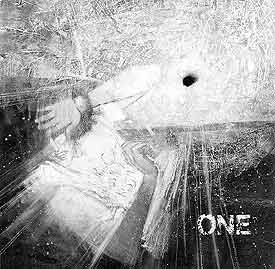
The speaker is an old man upset by the main character’s profanity, but Moore is talking to us. This is two years after he and David Lloyd completed their V for Vendetta. When they started the project in the early 80s, Lloyd told Moore he didn’t want any thought bubbles. This was a radical idea at the time, and possibly the biggest moment in Moore’s growth as a writer, because he went further and cut captions too. If no one was speaking, the panel would be wordless.
I think at the time, the record for longest silent sequence was still held by Jim Steranko, for the opening three pages of the 1968 Nick Fury: Agent of S.H.E.I.L.D. No. 1, for which, Steranko claims, Marvel didn’t want to pay his writing fee because he didn’t “write” anything.
Moore took Steranko’s experiment and turned it into his M.O. The first Watchmen script he gave Dave Gibbons included a four-page, 31-panel sequence, wordless but for Rorschach’s inarticulate grunts. Flipping through my copy of From Hell, I see Eddie Campbell draws as many as 7 consecutive pages of word-free narration. It’s a paradoxical approach for Moore, since his scripts are some of the most verbose imaginable—almost literalizing the a-picture-is-worth-a-thousand-words exchange rate.
So when I started talking with my friend Carolyn Capps—a painter and former next door neighbor—about collaborating on a comic book, I had Moore in mind. Is his old man right? Is there any need to use language? I recently finished revising a 71,338-word novel and drafting a 93,935-word non-fiction book, so I may be suffering from some of Moore’s perversity. But I just don’t like words in my comic books.
I’d suspected this for a while, but I proved it to myself when I looked at Brian K. Vaughan and Marcos Martín’s webcomic, The Private Eye. The publisher, PanelSyndicate.com, offers previews, three pages of each 32-page issue. I opened the first and was struck by the absence of words. No captions, no thought bubbles, no dialogue balloons. Just unimpeded visual storytelling. I loved it. I strained over an occasional panel, uncertain what exact information was being implied, but the story was all there, its effect all the more visceral by the effort required to follow it, the bursts of action followed by extended moments of minimal movement made more evocative by their lingering silence.
And then I purchased the first issue.
Turns out PanelSyndicate deletes talk bubbles for previews. When I purchased and “read” the same pages again, I was annoyed by the redundancies. Yes, I gained lots of new information, but none of it was worth the trade-off. Following the words from panel to panel means I was no longer primarily focused on the panels themselves. The images were serving the language. (Though, for the record, The Private Eye is still quite a good comic—it’s the industry’s words-first norms I’m annoyed about.)
When Carolyn and I started exchanging brainstorming emails, and then preliminary sketches and sample treatments, I wanted our story to evolve visually. Instead of her illustrating my script, I wanted her images to dictate the characters, situation, and plot. Carolyn’s first drawings were unsequenced, each a separate experiment, a testing of style and content. So I started experimenting too, testing out the rhythms of visual logic, the what-does-it-mean-if-this-goes-here grammar of panel language.
The results were pleasantly chaotic at times, the intended meanings subservient to the connotations of the actual images. Without explanatory captions or guiding dialogue, the pictures were the sole source of meaning, their tonal nuances more important than the scaffolding of the original script. No language also makes the reader a more active participant. Below is a six-panel sequence I cut and pasted from some of Carolyn’s earliest sketches. I knew what I wanted them to mean, but when I dragged my wife and daughter over to my laptop screen, they read them in their own ways.
Now you can decide what they say too:
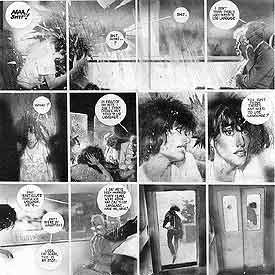

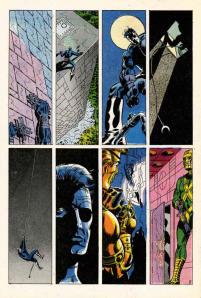
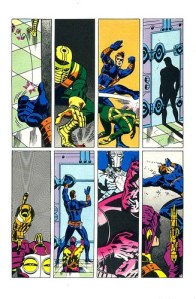
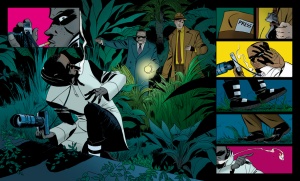
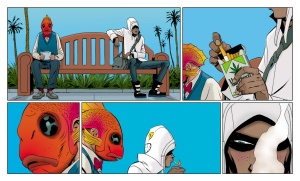
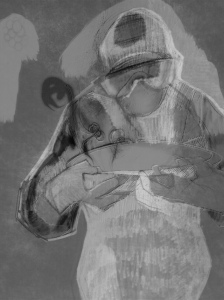



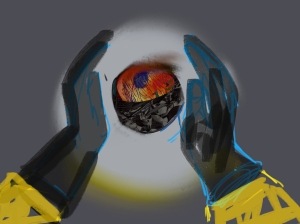
“I think, at the time, the record for longest silent sequence was still held by Jim Steranko,”
John Byrne published a one-word Batman story in 1989, one year before your Big Numbers example.
There’s a long list of other wordless comics here:
http://comics.lib.msu.edu/rhode/wordless.htm
Christine’s response to the old geezer – so you don’t think theres any need to use language? – was the point, no?
Moore’s move away from the wordier approach he used early on seemed to me to be about using language sparingly, rather than not at all. To more fully collaborate with the artist, to work with the visual logic you’re talking about.
Not that I disagree about comics without words, but I’m not sure how relevant Moore is to that, He seems to be aiming for more precision, not less.
“the record for longest silent sequence was still held by Jim Steranko, for the opening three pages of the 1968 Nick Fury: Agent of S.H.E.I.L.D. No. 1”
Not even close.
Thank you for the corrections! I hadn’t heard of either the 1989 Batman or 1984 G.I.Joe.
The GI Joe issue is 1.) great and 2.) pretty influential, at least according to interviews with artists in their late 30s-early 40s. I recall reading it when it came out, and immediately rereading it, my mind having been blown.
IDW recently put out a hardcover collecting the issue plus a lot of process stuff (pencil roughshod, etc), which is probably cheaper than an actual copy of the issue.
Marvel has been beating the drum on that GI Joe issue since it came out. That series was surprising fun as a kid but I haven’t revisited it since it was on the spinner racks.
They even did almost a whole month in tribute in 2001, The ‘Nuff Said event.
https://tapvd.home.xs4all.nl/SWW_Marvel_v01.html
I missed that event when it came out (mostly out of comics at that time) but read the Thunderbolts issue a few months back for marvelnoise. The creative team mostly accept the challenge but it felt a little bit of cheat at times. However I don’t mind a gimmick once in awhile, especially if it is not designed to try to get extra money out of me.
Should have posted this there but there is a trade of them.
http://marvel.com/comics/collection/1068/nuff_said_trade_paperback
Doesn’t appear to be on Marvel Unlimited yet but you can ping them about that.
However, I bet most of the issues are dirt cheap. I know that Thunderbolts one was. Some of the individual issues might be but I think the licenses go with the company (like when Dark Horse printed the Marvel Star Wars books in their trades) so the GI Joe stuff is probably not available to them.
There is a whole small subset of sequential art that contains no words in the wordless novel of which Lynd Ward is probably the biggest practitioner. Milt Gross also removed words for his work on He Done Her Wrong and in his “I Won’t Say a Word About” strips.
Yes, Lyn Ward is absolutely amazing.